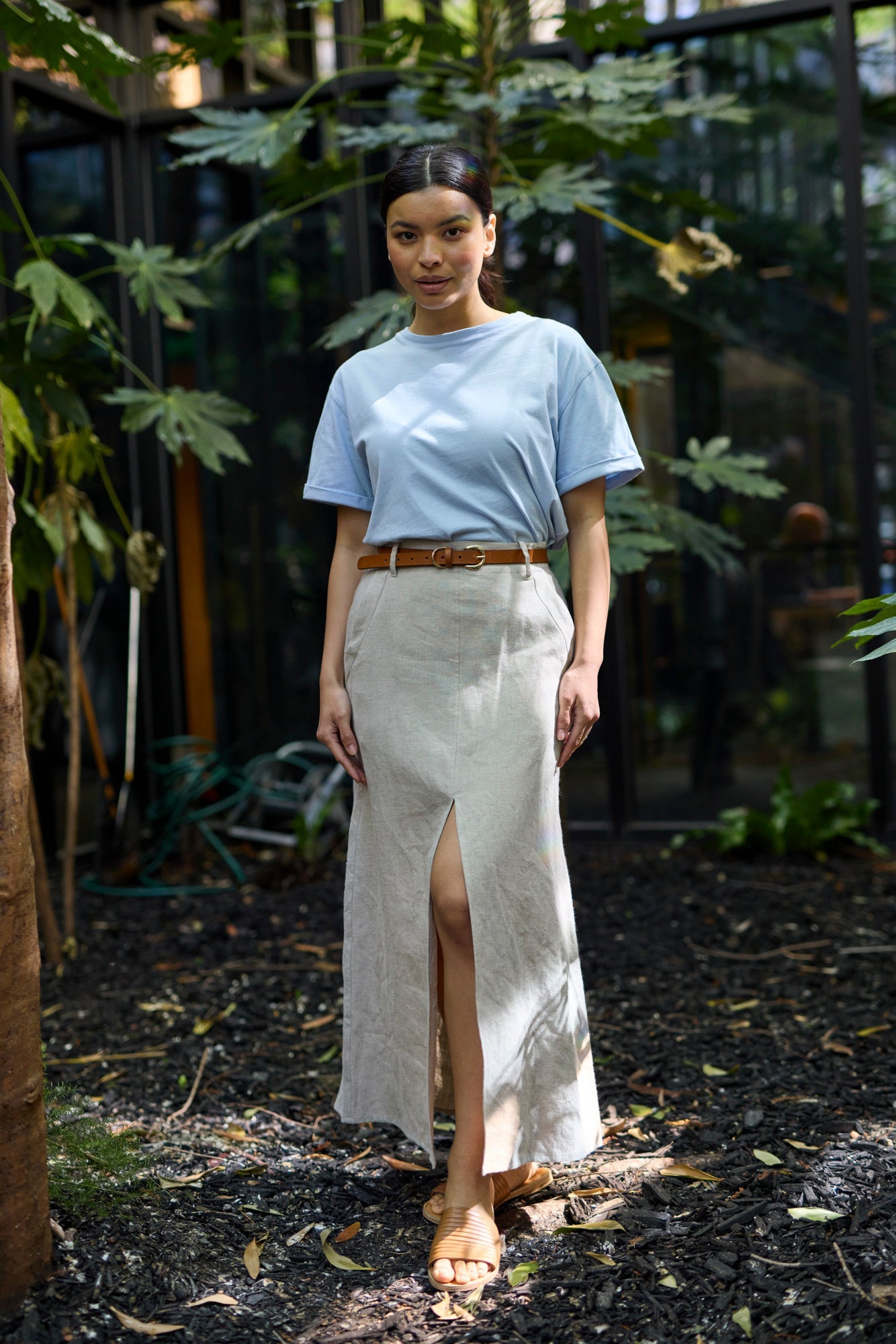How to Care for Your Woollen Knit: Merino Wool Clothing Australia Guide
Caring for your woollen knit is part of what makes it last. Especially with Merino wool—valued for its softness, breathability, and natural resilience—considered care helps preserve both its shape and its story. Gentle washing, careful drying, and mindful storage go a long way. With just a little attention, your knits will stay as timeless and beautiful as the day you first wore it—season after season.
At Matilda Life, we’re proud to work with Australian Merino wool, a fibre with deep roots in our landscape and a bright future in sustainable fashion. From regenerative farming to ethical production, Merino wool reflects a more thoughtful way to dress—one that honours both quality and country.
What is the Importance of Caring for Your Woollen Knit?
Woollen knits—especially those made from fine Merino wool—are more than just wardrobe staples; they’re an investment in lasting style and design. With the right care, preserving it's softness, shape, and colour can extend it's life well beyond a single season. Caring for quality Australian made fashion isn’t just practical—it’s purposeful. At Matilda Life, our garments are made to be worn, loved, and passed on—not replaced. Proper care is simply part of the story.
What Factors Influence the Longevity of Merino Wool Clothing? How do I care for it?
Merino wool is naturally soft, breathable, and made to last—but how you care for it makes all the difference. From how often you wear it to how it’s stored between seasons, small habits add up to long-term longevity. Here’s what matters most:
-
Rotate Your Wear: Let your knits rest between wears. It helps prevent stretching and keeps the shape intact.
-
Wash Gently: Wool doesn’t need frequent washing. Use a cool wool wash or hand wash when you do.
-
Air Dry: Skip the dryer. Lay flat and dry in the shade to preserve softness and structure.
-
Store carefully: Fold your knits. Keep them clean, dry, and away from moths with natural protectants.
-
Mend Early: Fix small snags before they grow. Spot clean gently when needed.
Caring for your clothes is part of the joy of owning them. It honours the people and materials behind each piece—keeping your wardrobe full of favourites, season after season.
How to Wash Your Merino Wool Clothing?
Merino wool is naturally resilient, but it responds best to a gentle touch. Whether you prefer a more personal hand wash approach or using a wool wash cycle.
Hand Wash
The most careful method and often the most rewarding.
-
Fill a clean basin with cool water.
-
Add a small amount of wool-specific detergent.
-
Submerge the garment and gently swirl for a few minutes—avoid scrubbing or twisting.
-
Rinse thoroughly in cool water until the detergent is gone.
-
Press out the excess water gently—never wring or twist.
Machine Wash
If your care label allows, machine wash is possible with the right settings.
-
Turn the garment inside out.
-
Place it in a mesh laundry bag for added protection.
-
Use the wool or delicate cycle with cool water.
-
Choose a gentle, wool-specific detergent.
-
Avoid fabric softeners, which can damage the fibres.
Always refer to your garment’s care label first—it’s there for a reason. Remember: with wool, less is more. A light, considered wash is all it takes to keep your knitwear feeling fresh without compromising its integrity.
How to Dry and Store Your Woollen Knit?
Drying and storing your wool garments matters just as much as how you wash them.
Avoid tumble dryers—heat can shrink or distort natural fibres. Instead, gently reshape your knit and lay it flat on a clean towel or drying rack, away from direct sunlight or heaters.
Always store woollens clean and completely dry. Fold them neatly and place in a cool, dry cupboard or drawer. To protect against moths, add natural deterrents like cedar balls, lavender sachets, or moth-repellent paper. Avoid hanging your knits, as this can stretch the shoulders and alter their fit.
How to Remove Stains from Your Wool Garments?
When it comes to stains, speed matters. The sooner you act, the better the result.
Blot gently with a clean cloth—never rub, as this can damage the fibres or spread the stain. Use a wool-safe stain remover or mix cool water with a little wool detergent. Always test on a hidden area first to check for discolouration. Once treated, rinse well with cool water and dry flat, away from direct heat.
Taking a gentle approach helps preserve both the look and feel of your knit.
How to Repair Common Damages in Woollen Clothing?
Even with care, wool can sometimes show signs of wear. Small holes or snags are part of a garment’s life—and they’re often easy to fix.
For tiny holes, use a needle and thread that blends with the fabric. Stitch gently to close the gap. If you spot a snag, use a crochet hook or needle to pull the thread through to the inside.
With visible damage, it’s worth visiting a trusted tailor or knitter. A thoughtful repair keeps your piece going, and honours the work that went into making it
What are the Benefits of Sustainable Merino Wool Clothing?
Merino wool clothing that you care for makes all the difference when considered sustainable clothes. With thoughtful washing and drying, your knitwear keeps its glow for years to come. That means fewer replacements, less waste, and more value in every wear.
What Makes Merino Wool So Special compared to Other Fibres?
Merino wool behaves differently compared to other fibres, especially when care is taken into consideration.
Where cotton may shrink and synthetics can lose their shape, Merino responds well to gentle handling. Wash it in cool water, avoid heat, and let it dry flat—no ironing or tumble drying needed.
This ease of care—paired with its natural odour resistance and ability to stay fresh between washes—means your Merino pieces last longer with less effort. At Matilda Life, we design with this in mind: clothing that’s as practical as it is beautiful, and made to stay in your wardrobe, not landfill.
What to Look for in Quality Australian Made Fashion
Quality starts with the details. When choosing Australian made clothing, look for clear labelling, well-executed stitching, and durable, high-quality fabrics like Merino wool, linen, or Tencel. A well-made garment should feel considered—inside and out.
Also pay attention to the brand behind the label. Ethical Australian fashion brands are transparent about where and how their garments are made, placing care, sustainability, and craftsmanship at the heart of everything they do.
How to Support Ethical Australian Brands
Supporting local, ethical fashion goes beyond buying a garment. Research the brand’s values, look for transparency in sourcing and production, and read customer reviews to understand how garments wear over time.
Buying directly from the brand ensures more of your money goes back into local makers and businesses. And don’t underestimate the power of word-of-mouth—sharing your support helps grow a more thoughtful, sustainable fashion community across Australia.
Why Care and Conscious Choices Matter
Caring for your woollen knit is more than a routine—it’s a reflection of what you value. With simple, mindful habits, your Merino wool clothing can remain part of your wardrobe for years, not just seasons. Washing gently, drying carefully, and storing with intention all help preserve their beauty and fit.
But it starts with the choice to invest in quality. Choosing sustainable fashion—especially pieces made here in Australia—means supporting ethical production, local craftsmanship, and materials that are kinder to the planet. We believe this is fashion with purpose: well-made garments, worn often, and kept for the long run. It’s an investment in your style, your values, and a more considered future.






